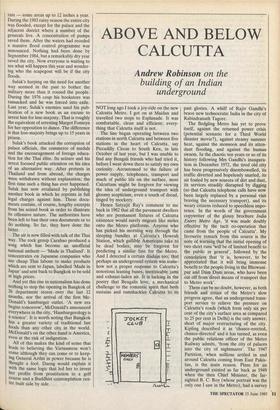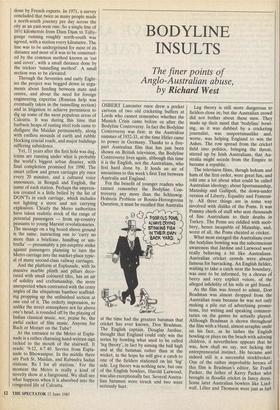ABOVE AND BELOW CALCUTTA
Andrew Robinson on the
building of an Indian underground
NOT long ago I took a joy-ride on the new Calcutta Metro. I got on at Maidan and travelled two stops to Esplanade. It was comfortable, clean and efficient; every- thing that Calcutta itself is not.
The line began operating between two stations in north Calcutta and between five stations in the heart of Calcutta, say Piccadilly Circus to South Ken, in late October of last year, but I was unable to find any Bengali friends who had tried it, before I went down there to satisfy my own curiosity. Accustomed to the failure of power supply, telephones, transport and much of public life on the surface, most Calcuttans might be forgiven for viewing the idea of underground transport with gloomy scepticism, even a touch of dread, tinged by mockery.
Hence Satyajit Ray's comment to me back in 1982 that all the pavement dwellers who are permanent fixtures of Calcutta existence would surely migrate like moles onto the Metro platforms. Anyone who has picked his morning way through the sleeping bundles at Calcutta's Howrah Station, which gullible Americans take to be dead bodies, may be forgiven for predicting a similar fate for the Metro. And I detected a certain disdain too; that perhaps an underground system was some- how not a proper response to Calcutta's notorious leaning buses, inextricable jams and exhaust-laden air. It is lacking in the poetry that Bengalis love, a mechanical challenge to the romantic spirit that both sustains and ramshackles Calcutta to its past glories. A whiff of Rajiv Gandhi's brave new technocratic India in the city of Rabindranath Tagore.
The fledgling Metro has yet to prove itself, against the returned power crisis (potential scenario for a Third World disaster movie?), against steamy summer heat, against the monsoon and its atten- dant flooding, and against the human swarm. In the chaotic ten years or so of its history following Mrs Gandhi's inaugura- tion in December 1972, the tired old city has been progressively disembowelled, its traffic diverted and hopelessly snarled, its air fouled by new sources of dirt and dust, its services steadily disrupted by digging (so that Calcutta telephone calls have now been largely replaced by a personal visit braving the necessary transport), and its weary citizens reduced to speechless impo- tence. In the words of the government copywriter of the glossy brochure India Enters Metro Age, 'it was made doubly effective by the tacit co-operation that came from the people of Calcutta'. My favourite remark from this source is the note of warning that the initial opening of two short runs 'will be of limited benefit to the public in general', followed by the consolation that 'it is, however, to be appreciated that it will bring immense benefit to the people living in the Bhowani- pur and Dum Dum areas, who have been cut off from direct means of transport due to Metro work'.
There can be no doubt, however, as both friends and critics of the Metro's slow progress agree, that an underground trans- port service to relieve the pressure on Calcutta's roads (which form only six per cent of the city's surface area as compared to 25 per cent in Delhi) is the only answer, short of major restructuring of the city. Kipling described it as 'chance-erected, chance-directed' and it has turned, as even the public relations officer of the Metro Railway admits, 'from the city of palaces into the city of nightmares'. The 1947 Partition, when millions settled in and around Calcutta coming from East Pakis- tan, is the main reason. Plans for an underground existed as far back as 1949 when the then Chief Minister, the far- sighted B. C. Roy (whose portrait was the only one I saw in the Metro), had a survey done by French experts. In 1971, a survey concluded that twice as many people made a north-south journey per day across the city as an east-west one. So a single line of 161/2 kilometres from Dum Dum to ToIly- gunge running roughly north-south was agreed, with a station every kilometre. The line was to be underground for most of its distance and most of it was to be construct- ed by the common method known as 'cut and cover', with a small distance done by the trickier 'tunnelling method'. A small section was to be elevated.
Through the Seventies and early Eight- ies the project was bogged down in argu- ments about funding between state and centre, and about the need for foreign engineering expertise (Russian help was eventually taken in the tunnelling section) and in litigation to achieve permission to dig up some of the most populous areas of Calcutta. It was during this time that barbaric heaps of rusting steel rods came to disfigure the Maidan permanently, along with endless mounds of earth and rubble blocking crucial roads, and major buildings suffering subsidence.
Yet, 11 years after the first hole was dug, trains are running under what is probably the world's biggest urban disaster, with final completion promised for 1990. The smart yellow and green carriages ply once every 20 minutes, and a cultured voice announces, in Bengali and English, the name of each station. Perhaps the impress- ion created is a little belied by the list of DON'Ts in each carriage, which includes not lighting a stove and not carrying explosives. Clearly the Metro authorities have taken realistic stock of the range of potential passengers — from up-country peasants to young Marxist revolutionaries. The message on a big board above ground is the same, instructing one to 'carry no more than a briefcase, handbag or um- brella' — presumably a pre-emptive strike against passengers planning to turn the Metro carriage into the market-place typic- al of many second-class railway carriages.
And the platform at Esplanade, with its massive marble plinth and pillars deco- rated with small coloured tiles, has an air of solidity and craftsmanship, the more unexpected when contrasted with the crazy angles of the ubiquitous bamboo scaffold- ing propping up the unfinished section at one end of it. The orderly impression, so unlike the street atmosphere not far above one's head, is rounded off by the playing of Indian classical music, not, praise be, the awful racket of film music. Anyone for Bach or Mozart on the Tube?
At the entrance to the Metro at Espla- nade is a rather charming hand-written sign tacked to the mouth of the stairwell. It reads: '9-12, 4-7.40. Service from Espla- nade to Bhowanipur. In the middle there are Park St, Maidan, and Rabindra Sadan stations. Rs I for all stations.' For the moment the Metro is really a kind of novelty show at a fairground. We shall see what happens when it is absorbed into the congested life of Calcutta.



















































 Previous page
Previous page